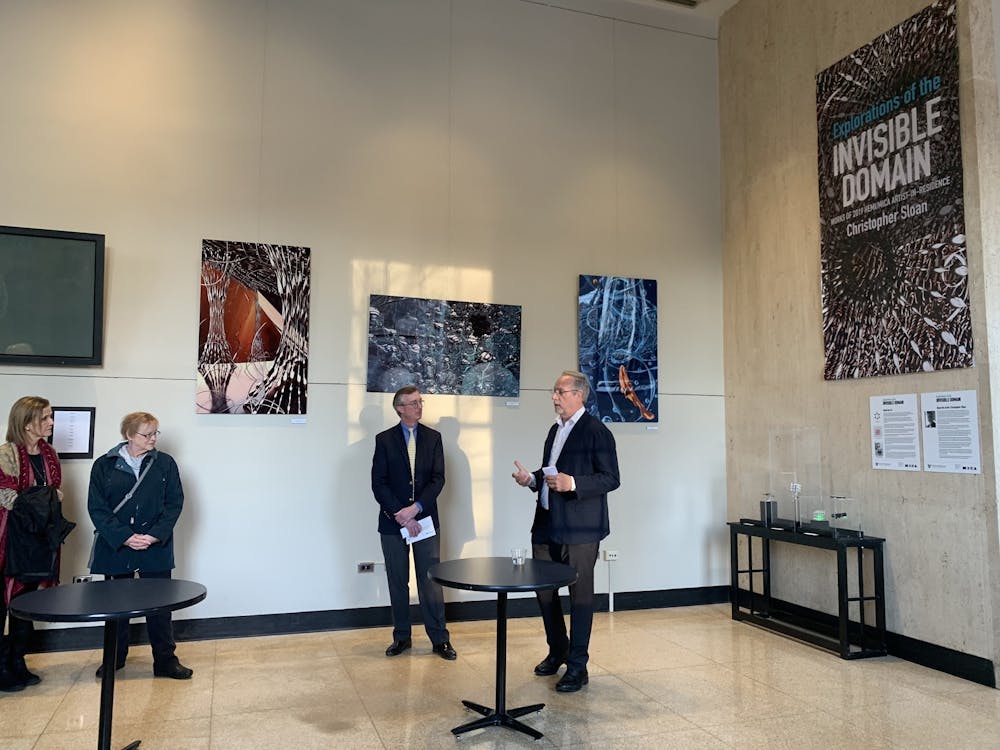The latest installment of the 2020 HEMI/MICA Artist in Residence exhibition, Explorations of the Invisible Domain, debuted on Friday, March 6.
The Artist in Residence program is the culmination of a joint venture between the Hopkins Extreme Materials Institute (HEMI) and Maryland Institute College of Art (MICA) known as the HEMI/MICA Extreme Arts Program (HMEAP).
The goal of the program is to bring together faculty from both institutions to find creative ways to visualize and interpret the complexities of HEMI research.
HMEAP began in 2015 after program directors at HEMI approached MICA with an idea for an interdisciplinary collaboration. K.T. Ramesh, director of HEMI, described the genesis of the program.
“Lori [Graham-Brady, associate director of HEMI,] and I realized that a lot of our problems involve lots of data and we always had trouble visualizing it,” Ramesh said.
In considering new ways to look at their data, the innovative process of artists came to mind.
“What the artist is able to do is come in and listen to us and talk to us, and then develop a way of thinking that is easily communicated even to another scientist,” Ramesh said. “That kind of ability to translate and reimagine, and re-visualize things is really valuable.”
The current installment of the exhibition was created by artist and faculty member at MICA and the Art Academy University in San Francisco, Christopher Sloan.
The exhibit is a mixed-media installation, and includes lasers, 3-D models, digital images and video inspired by the research of Professors James Spicer, En Ma, Joelle Frechette and their students.
Although Sloan is a novice in the molecular, atomic and subatomic-level projects the researchers were working on, his art has long focused on “invisible” concepts, such as human perception.
“Getting engaged with research is something I really love to do. And this program dovetailed really well with my lifelong interest in the nature of things. I’m really curious about what things look like that we can’t see,” Sloan explained.
Sloan, who describes his art as conceptual realism, highlighted the importance of beginning his creative process with research about the subject he hopes to depict.
For this part of his process, Sloan reached out to a number of researchers at HEMI. Subsequent meetings with them and their students helped him to further understand the complex research they were conducting.
Sloan typically works in oil, but the pieces in Explorations of the Invisible Domain were created through digital technologies: 3D modeling and 3D printing. He cited time constraints as his reason for diverging from his usual medium of oil.
While Sloan described the digital process as uncertain and challenging, he noted the presence of uncertainty when working in any medium.
“Whether working in oils or digital, like this [project], it’s really the same process. It’s almost like cooking. You’re throwing a bunch of things into the pot, you know what the ingredients are because that’s what came out of your research, but you don’t know where it’s going to go,” Sloan said.
Ultimately, he became more comfortable and satisfied with the digital process the more he worked on it and even found joy in the explorative process.
“In a 3D modeling program you can create a space, it’s very dimensional. Once I had some of these basic shapes it was like a fantastic voyage. I could sort of go in there, and I could move around the atoms and these molecules, and I could choose where I wanted to be. It was very much like exploration,” Sloan said.
Attendees were excited about the collision of art and science that is central to HMEAP exhibits. Kirk Amaral Snow, an administrator for the Office of Research at MICA, which helps facilitate different collaborations between MICA and various institutions, spoke about his own anticipation.
“We’re just really interested in this idea of finding the synergies between what artists do and what scientists do as people who sometimes systematically investigate things, different ideas and questions. So, it’s always really interesting to see the outcome of how the meeting of the minds come together as the final exhibition for these visiting artists,” Snow said.
Senior Grace Windheim also expressed excitement about HMEAP’s intersection of art, engineering and technology. Over the years, students have enjoyed walking by the exhibit and interacting with the different forms each project has taken.
“I do appreciate that they put it in a public space where anyone is really walking through, instead of shoving it into a room or just doing it on one night,” Windheim said.
Tyler Spoleti, a senior studying Mechanical Engineering, drew connections between the HMEAP collaboration and one of his courses, Fabricatology — Advanced Materials Processing. Last week, Jenna Frye, the previous HMEAP artist in residence, delivered a guest lecture in the class. The lecture sparked Spoleti’s interest in the exhibit.
The two enjoyed the exhibit, but wished it had included a deeper explanation about the artist’s creative process and finished product.
Nevertheless, each student hoped to see more of the HEMI/MICA project collaboration.
“I hope they do this next year, I’ll still be here,” Spoleti said.
The exhibit can be viewed on Q-Level of the Milton S. Eisenhower Library from now until April 10, 2020.





